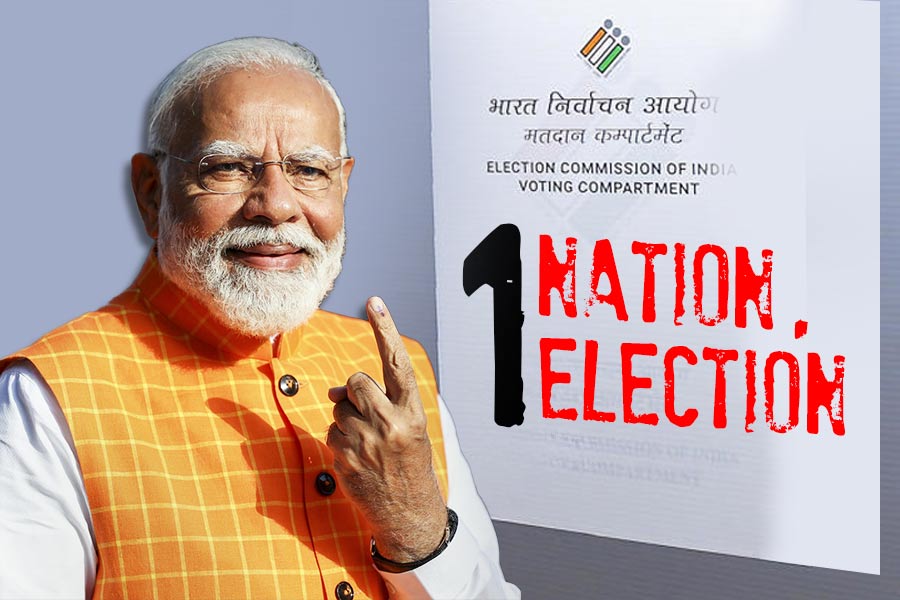The Union cabinet on Wednesday put its seal of approval on the Narendra Modi government’s pet project of “one nation, one election”.
The cabinet unanimously accepted all the recommendations of the High Level
Committee Report on Simultaneous Elections in India, chaired by former President Ram Nath Kovind. The earliest possible simultaneous elections under this plan is in
2034. The government remained tight-lipped on when exactly the regime would be implemented.
The Opposition on Wednesday criticised the government’s acceptance of the Kovind committee report, calling it another headline-grabbing manoeuvre by the
Modi administration and a jumla.
In March, the Kovind committee had recommended that elections for the Lok Sabha and the Assemblies in the states be held together. It also suggested that polls to local bodies — the three-tier panchayats and the municipalities and municipal corporations — be held within 100 days of the general election.
Of the 47 parties that gave representations to the committee, 32 supported simultaneous elections. These include only two national parties — the BJP and its ally, the Meghalaya-based National People’s Party.
Announcing the decision to approve the recommendations of the Kovind panel, Union minister Ashwini Vaishnaw cited the Law Commission report of 1999 which had also recommended simultaneous polls.
“So that development continues and the huge expenditure on elections is reduced,” Vaishnaw said while justifying the decision, adding that law and order as well as the criminal justice system are “impeded because policemen are totally deployed” for poll-related duties. He said the government did not want such “disruptions” and “today’s youth, today’s Bharat aspires for speedy development”.
The Kovind report recommends two main constitutional amendments:
◙ Article 82A; Duration of House of People under Article 83(2), Article 83(3), Article 83(4); duration of State Legislature Assembly under Article 172(3), Article 172(4), Article 172(5) and Article 327. The amendment bill will not require the ratification of the states.
◙ The amendment to the provisions of the Constitution relating to the preparation of the electoral roll by the Election Commission of India in consultation with the state election commissions for polls to the local bodies (under Article 325). The amendment is needed to provide for simultaneous elections to municipalities and panchayats along with the general election and the Assembly polls (Article 324A). Under Article 368(2), ratification by not less than half of the states will be required to carry out this amendment.
Separate amendments would have to be passed for the three Union Territories with Assemblies — Delhi, Puducherry and Jammu and Kashmir.
The minister harped on “consensus” when asked for a timeline of implementation of the one nation, one poll formula and how the government hoped to get two-thirds majority in support of the bill in both Houses of Parliament and the backing of half the states.
“Our government believes in creating consensus on items that affect our democracy, our nation in the long run…. The honourable home minister said in front of all of you yesterday that we would implement it in this term,” Vaishnaw said.
The minister was questioned if reducing the number of election cycles would restrict the elbow room of the government to implement corrective policy action based on public sentiment. “Our government believes in the consultative process…. I don’t think election results should be seen as a barometer of people’s feedback,” Vaishnaw said.
Elections for the Lok Sabha and the Assemblies happened simultaneously till 1962, but Nagaland became a state the following year and had its first elections in 1964. Several Assemblies were prematurely dissolved and many new Assemblies have been created since.
The idea of having simultaneous polls at the national and state levels has been discussed by the Law Commission of India (LCI) and in Parliament.
The LCI’s 170th report in 1999 said: “It is true that we cannot conceive or provide for all the situations and eventualities that may arise whether on account of the use of Article 356 (which of course has come down substantially after the decision of Supreme Court in S.R. Bommai v. Union of India) or for other reasons, yet the holding of a separate election to a Legislative Assembly should be an exception and not the rule. The rule ought to be ‘one election once in five years for Lok Sabha and all the Legislative Assemblies’.”
In 2015, the 79th report of the Department Related Parliament Standing Committee on Personnel, Public Grievances, Law and Justice suggested that Assembly polls could be held in two batches — the first in 2016 and the second with the Lok Sabha polls in 2019. It also suggested that all bypolls be held in a fixed period every year.
The report, under the chairmanship of Congress MP E.M. Sudarsana Natchiappan, quoted the Election Commission of India as saying: “Presently, the cost of holding elections for Lok Sabha and Legislative Assemblies of states and UTs has been pegged at ₹4,500 crore.”
It added: “The ECI has also pointed out several difficulties which might be encountered for conducting simultaneous elections. The chief issue highlighted by them is that simultaneous conduct of elections would require large-scale purchase of Electronic Voting Machines and Voter Verifiable Paper Audit Trail (VVPAT) machines. For conducting simultaneous elections, the commission expects that a total of ₹9,284.15 crore will be needed for the procurement of EVMs and VVPATs. The machines would also be needed to be replaced every fifteen years which would again entail expenditure. Further, storing these machines would increase the warehousing cost.”
However, the EC also pointed out that simultaneous elections would reduce the prolonged deployment of personnel, especially security forces, for poll duty.










